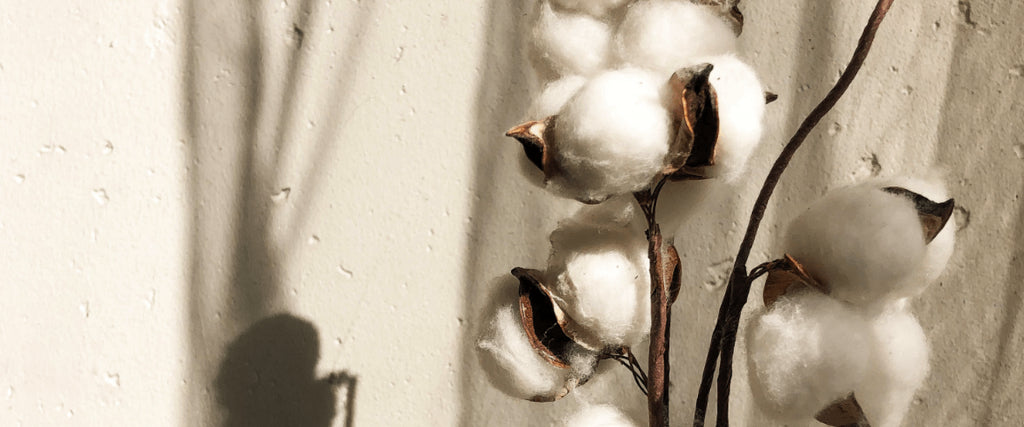To help make things a bit clearer, we thought we’d take a closer look at two of the most popular cotton types that people are seeking out: pima cotton and ‘organic’ cotton: They are quite different from each other but in their own way, they can both be sustainable. Let’s explore each one in a bit more detail and find out what the differences are.
What is Pima / Supima cotton?
- Cotton fibre length: long
- Key advantage: quality
- Made: in developed and developing countries
- Expense: high.
Pima cotton is a type of premium cotton with a long fibre length, which is a characteristic also known as ‘extra long staple’ (or ELS). Clothes made from this type of cotton tend to be soft, durable, and long-lasting. Pima cotton is grown from a particular species of cotton plant, Gossypium barbadense, and is regarded as one of the world’s finest, when pure.
Brands using Pima cotton can apply to use the term ‘Supima’. It’s a legal trademark awarded by the non-profit Supima organisation. To qualify for the ‘Supima’ label, the Pima cotton that’s used needs to be 100% pure and grown in the United States. However it is still, to all intents and purposes, Pima cotton and not a special type. In short, Supima is 100% Pima cotton that’s grown in the USA and certified for its purity and origin.
As of yet, Pima cotton is not organically farmed, which brings us onto the next section…

What is organic cotton?
- Cotton fibre length: short to medium
- Key advantage: eco-friendly farming
- Made: in developing countries
- Expense: medium to high – depending on certification.
Organic cotton is simply cotton that has been organically farmed. This typically means that no harmful pesticides or chemical inputs have been used in production. But beware: the word ‘organic’ can be a vague term that can result in greenwashing because its use isn’t strictly defined, legally.
As such, it’s best to seek out organic cotton that is certified by a respected body, such as by GOTS (the Global Organic Textile Standard). GOTS certified cotton also includes controls on labour conditions and quality, which go beyond the organic classification used by most. Read more here to find out more about GOTS certified cotton and its criteria for certification.
Another key difference between organic cotton and Pima / Supima cotton is that the organic label does not refer to a particular species of cotton – just the way the cotton is farmed. In fact, most cotton grown as organic tends to be of shorter fibre length than Pima – meaning the quality is lower.
Pima & Supima Cotton vs. Organic Cotton for sustainability:
- Pima / Supima is not farmed organically but is sustainable because of longevity
- Organic cotton is sustainable because of its eco-friendly farming and production.
So, which is the winner in the sustainability stakes?
Well, it’s about a draw because sustainability comes in many shapes. Pima / Supima cotton might not be organically farmed but clothes made from this high-quality cotton are sustainable because they last a long time. They don’t have to be sent to landfill and replaced – repeating the environmental impact. That said, it’s even better to source Pima cotton from suppliers that operate in a more sustainable way, such as those used by SANVT in the USA.
Organic cotton, on the other hand, is produced in a way that’s more overtly kind to the environment. But because the cotton itself is lower quality, garments made from organic cotton don’t last as long. And also, as organic cotton tends to be produced in developing countries, there are sometimes dubious conditions for workers.
So, to get the best from organic cotton, SANVT’s advice is to look for a respected organic certification, such as GOTS which has controls on production and quality to meet the mark. That way, you’ll be getting more of an optimal mix of quality and sustainability.
Influencer suzannazen is wearing the Unisex Lightweight T-Shirt in White. She enjoys wearing our sustainable essentials made from natural fibers, as they are much softer and more comfortable than synthetic clothing.
Pima & Supima Cotton vs. Organic Cotton – key differences:
Finally, to recap on some of the key differences covered in the post:
- Pima cotton is not organically farmed, organic cotton is
- Pima cotton is more expensive than organic cotton
- Pima cotton, because of the longer fibres, is higher quality than organic cotton
- Both can be sustainable fabrics in their own way.
Conclusion:
There’s no victor here. As you can see, both types of cotton are different with distinct advantages. SANVT uses both types because they both result in the sustainable garments that we take pride in making.
For instance, in SANVT’s Perfect T-Shirt we use 100% ELS Pima cotton – and in our Heavyweight T-Shirt we use GOTS-certified organic cotton.
Keen to know a bit more about cotton, including other types beyond organic and Pima? Find out more on some of the links below:



